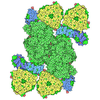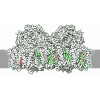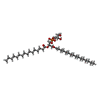[English] 日本語
 Yorodumi
Yorodumi- PDB-8s6h: Cryo-EM Structure of the R388 plasmid conjugative pilus reveals a... -
+ Open data
Open data
- Basic information
Basic information
| Entry | Database: PDB / ID: 8s6h | ||||||
|---|---|---|---|---|---|---|---|
| Title | Cryo-EM Structure of the R388 plasmid conjugative pilus reveals a helical polymer characterised by an unusual pilin/phospholipid binary complex | ||||||
 Components Components | TrwL protein | ||||||
 Keywords Keywords | PROTEIN FIBRIL / Conjugal transfer protein / VirB2 / Conjugative pilus / Type-4 secretion system fibre / Conduit for horizontal gene transfer / anti-microbial resistance | ||||||
| Function / homology | Conjugal transfer TrbC/type IV secretion VirB2 / TrbC/VIRB2 pilin / membrane / 1,2-DIPALMITOYL-PHOSPHATIDYL-GLYCEROLE / TrwL protein Function and homology information Function and homology information | ||||||
| Biological species |  | ||||||
| Method | ELECTRON MICROSCOPY / helical reconstruction / cryo EM / Resolution: 3.39 Å | ||||||
 Authors Authors | Vadakkepat, A.K. / Waksman, G. / Redzej, A. | ||||||
| Funding support |  United Kingdom, 1items United Kingdom, 1items
| ||||||
 Citation Citation |  Journal: Structure / Year: 2024 Journal: Structure / Year: 2024Title: Cryo-EM structure of the R388 plasmid conjugative pilus reveals a helical polymer characterized by an unusual pilin/phospholipid binary complex. Authors: Abhinav K Vadakkepat / Songlin Xue / Adam Redzej / Terry K Smith / Brian T Ho / Gabriel Waksman /  Abstract: Bacterial conjugation is a process by which DNA is transferred unidirectionally from a donor cell to a recipient cell. It is the main means by which antibiotic resistance genes spread among bacterial ...Bacterial conjugation is a process by which DNA is transferred unidirectionally from a donor cell to a recipient cell. It is the main means by which antibiotic resistance genes spread among bacterial populations. It is crucially dependent upon the elaboration of an extracellular appendage, termed "pilus," by a large double-membrane-spanning secretion system termed conjugative "type IV secretion system." Here we present the structure of the conjugative pilus encoded by the R388 plasmid. We demonstrate that, as opposed to all conjugative pili produced so far for cryoelectron microscopy (cryo-EM) structure determination, the conjugative pilus encoded by the R388 plasmid is greatly stimulated by the presence of recipient cells. Comparison of its cryo-EM structure with existing conjugative pilus structures highlights a number of important differences between the R388 pilus structure and that of its homologs, the most prominent being the highly distinctive conformation of its bound lipid. | ||||||
| History |
|
- Structure visualization
Structure visualization
| Structure viewer | Molecule:  Molmil Molmil Jmol/JSmol Jmol/JSmol |
|---|
- Downloads & links
Downloads & links
- Download
Download
| PDBx/mmCIF format |  8s6h.cif.gz 8s6h.cif.gz | 954.2 KB | Display |  PDBx/mmCIF format PDBx/mmCIF format |
|---|---|---|---|---|
| PDB format |  pdb8s6h.ent.gz pdb8s6h.ent.gz | Display |  PDB format PDB format | |
| PDBx/mmJSON format |  8s6h.json.gz 8s6h.json.gz | Tree view |  PDBx/mmJSON format PDBx/mmJSON format | |
| Others |  Other downloads Other downloads |
-Validation report
| Summary document |  8s6h_validation.pdf.gz 8s6h_validation.pdf.gz | 4.3 MB | Display |  wwPDB validaton report wwPDB validaton report |
|---|---|---|---|---|
| Full document |  8s6h_full_validation.pdf.gz 8s6h_full_validation.pdf.gz | 4.5 MB | Display | |
| Data in XML |  8s6h_validation.xml.gz 8s6h_validation.xml.gz | 156.1 KB | Display | |
| Data in CIF |  8s6h_validation.cif.gz 8s6h_validation.cif.gz | 214.7 KB | Display | |
| Arichive directory |  https://data.pdbj.org/pub/pdb/validation_reports/s6/8s6h https://data.pdbj.org/pub/pdb/validation_reports/s6/8s6h ftp://data.pdbj.org/pub/pdb/validation_reports/s6/8s6h ftp://data.pdbj.org/pub/pdb/validation_reports/s6/8s6h | HTTPS FTP |
-Related structure data
| Related structure data |  19758MC M: map data used to model this data C: citing same article ( |
|---|---|
| Similar structure data | Similarity search - Function & homology  F&H Search F&H Search |
- Links
Links
- Assembly
Assembly
| Deposited unit | 
|
|---|---|
| 1 |
|
- Components
Components
| #1: Protein | Mass: 7396.732 Da / Num. of mol.: 69 / Source method: isolated from a natural source Details: The first 43 amino acids have been cleaved off from the pro-pilin TrwL/VirB2 during post-translational processing for maturation. Source: (natural)  #2: Chemical | ChemComp-LHG / Has ligand of interest | Y | |
|---|
-Experimental details
-Experiment
| Experiment | Method: ELECTRON MICROSCOPY |
|---|---|
| EM experiment | Aggregation state: HELICAL ARRAY / 3D reconstruction method: helical reconstruction |
- Sample preparation
Sample preparation
| Component | Name: Conjugative pilus from the E. coli R388 plasmid / Type: COMPLEX Details: Helical filament called the conjugative pilus. This is part of the type-4 secretion system. Monomeric unit of the complex comprises of the protein VirB2/TrwL (for R388 pilus) and a lipid PG 32.1 Entity ID: #1 / Source: NATURAL | |||||||||||||||||||||||||
|---|---|---|---|---|---|---|---|---|---|---|---|---|---|---|---|---|---|---|---|---|---|---|---|---|---|---|
| Molecular weight | Value: 7.39 kDa/nm / Experimental value: YES | |||||||||||||||||||||||||
| Source (natural) | Organism:  | |||||||||||||||||||||||||
| Buffer solution | pH: 7.4 / Details: Phosphate buffer saline | |||||||||||||||||||||||||
| Buffer component |
| |||||||||||||||||||||||||
| Specimen | Conc.: 0.25 mg/ml / Embedding applied: NO / Shadowing applied: NO / Staining applied: NO / Vitrification applied: YES / Details: This specimen was purified to high levels. | |||||||||||||||||||||||||
| Specimen support | Grid material: COPPER/PALLADIUM / Grid mesh size: 400 divisions/in. / Grid type: C-flat-1.2/1.3 | |||||||||||||||||||||||||
| Vitrification | Instrument: FEI VITROBOT MARK IV / Cryogen name: ETHANE / Humidity: 100 % / Chamber temperature: 277.15 K Details: C-flat grids (Protochips, US 1.2/1.3 400 mesh) were negatively glow discharged using PELCO Easiglow (Ted Pella, USA) and coated with graphene oxide. 3 microliter of the purified pili sample ...Details: C-flat grids (Protochips, US 1.2/1.3 400 mesh) were negatively glow discharged using PELCO Easiglow (Ted Pella, USA) and coated with graphene oxide. 3 microliter of the purified pili sample was applied on each grid and a Vitrobot Mark IV (Thermo Fisher Scientific, USA) operating at 4C and 100 percent humidity was used to incubate the sample on the grid for 30 secs and blotting for 16 secs (blot force -10) prior to vitrification in liquid ethane. |
- Electron microscopy imaging
Electron microscopy imaging
| Experimental equipment |  Model: Titan Krios / Image courtesy: FEI Company |
|---|---|
| Microscopy | Model: FEI TITAN KRIOS Details: The R388 pilus data were collected at the ISMB Birkbeck EM facility using a Titan Krios microscope (Thermo Fisher Scientific, USA) operated at 300 keV and equipped with a BioQuantum energy ...Details: The R388 pilus data were collected at the ISMB Birkbeck EM facility using a Titan Krios microscope (Thermo Fisher Scientific, USA) operated at 300 keV and equipped with a BioQuantum energy filter (Gatan, USA) with a slit width of 20 eV. The images were collected with a post-GIF K3 direct electron detector (Gatan, USA) operating in super resolution mode, at a magnification of 81,000 corresponding to a pixel size of 1.067 A. The dose rate was set to 14.62 e per pixel per second and a total dose of 34.67 e per A2 was fractionated over 50 frames. |
| Electron gun | Electron source:  FIELD EMISSION GUN / Accelerating voltage: 300 kV / Illumination mode: FLOOD BEAM FIELD EMISSION GUN / Accelerating voltage: 300 kV / Illumination mode: FLOOD BEAM |
| Electron lens | Mode: BRIGHT FIELD / Nominal magnification: 81000 X / Calibrated magnification: 81000 X / Nominal defocus max: 2400 nm / Nominal defocus min: 900 nm / Calibrated defocus min: 900 nm / Calibrated defocus max: 2400 nm / Cs: 2.7 mm / Alignment procedure: COMA FREE |
| Specimen holder | Cryogen: NITROGEN / Specimen holder model: FEI TITAN KRIOS AUTOGRID HOLDER / Temperature (max): 80 K / Temperature (min): 80 K |
| Image recording | Electron dose: 34.67 e/Å2 / Film or detector model: GATAN K3 BIOQUANTUM (6k x 4k) / Num. of real images: 4884 Details: The R388 pilus data were collected at the ISMB Birkbeck EM facility using a Titan Krios microscope (Thermo Fisher Scientific, USA) operated at 300 keV and equipped with a BioQuantum energy ...Details: The R388 pilus data were collected at the ISMB Birkbeck EM facility using a Titan Krios microscope (Thermo Fisher Scientific, USA) operated at 300 keV and equipped with a BioQuantum energy filter (Gatan, USA) with a slit width of 20 eV. The images were collected with a post-GIF K3 direct electron detector (Gatan, USA) operating in super resolution mode, at a magnification of 81,000 corresponding to a pixel size of 1.067 A. The dose rate was set to 14.62 e per pixel per second and a total dose of 34.67 e per A2 was fractionated over 50 frames. Data were collected using the EPU software with a defocus range 0.9 micrometer to 2.4 micrometer and a total of 4884 movies were collected. |
- Processing
Processing
| EM software |
| ||||||||||||||||||||||||||||||||||||||||
|---|---|---|---|---|---|---|---|---|---|---|---|---|---|---|---|---|---|---|---|---|---|---|---|---|---|---|---|---|---|---|---|---|---|---|---|---|---|---|---|---|---|
| Image processing | Details: Find more details in the Methods section of the publication | ||||||||||||||||||||||||||||||||||||||||
| CTF correction | Details: Find more details in the Methods section of the publication Type: PHASE FLIPPING AND AMPLITUDE CORRECTION | ||||||||||||||||||||||||||||||||||||||||
| Helical symmerty | Angular rotation/subunit: 28.983 ° / Axial rise/subunit: 13.241 Å / Axial symmetry: C1 | ||||||||||||||||||||||||||||||||||||||||
| Particle selection | Num. of particles selected: 1158759 Details: Find more details in the Methods section of the publication | ||||||||||||||||||||||||||||||||||||||||
| 3D reconstruction | Resolution: 3.39 Å / Resolution method: FSC 0.143 CUT-OFF / Num. of particles: 209930 Details: Find more details in the Methods section of the publication Num. of class averages: 3 / Symmetry type: HELICAL | ||||||||||||||||||||||||||||||||||||||||
| Atomic model building | B value: 109.7 / Protocol: RIGID BODY FIT / Target criteria: Cross-correlation in Phenix Details: Find more details in the Methods section of the publication | ||||||||||||||||||||||||||||||||||||||||
| Atomic model building | Source name: AlphaFold / Type: in silico model | ||||||||||||||||||||||||||||||||||||||||
| Refinement | Cross valid method: NONE Stereochemistry target values: GeoStd + Monomer Library + CDL v1.2 | ||||||||||||||||||||||||||||||||||||||||
| Displacement parameters | Biso mean: 90.07 Å2 | ||||||||||||||||||||||||||||||||||||||||
| Refine LS restraints |
|
 Movie
Movie Controller
Controller






 PDBj
PDBj





